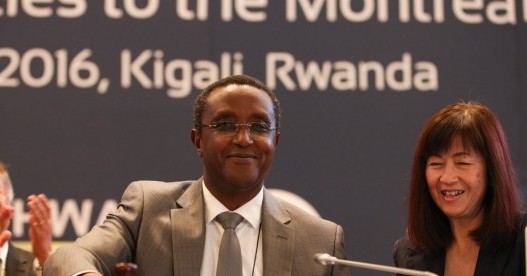
A historic global climate deal was reached in Kigali, Rwanda at the Twenty-Eighth Meeting of the Parties to the Montreal Protocol on Substances that Deplete the Ozone Layer (MOP28).
The so called Kigali Amendment which amends the 1987 Montreal Protocol aims to phase out Hydrofluorocarbons (HFCs), a family of potent greenhouse gases by the late 2040s.
Under Kigali Amendment, in all 197 countries, including India have agreed to a timeline to reduce the use of HFCs by roughly 85% of their baselines by 2045.
What is significance of the Kigali Amendment?
The Kigali Amendment amends the 1987 Montreal Protocol that was designed to close growing ozone hole in by banning ozone-depleting coolants like chlorofluorocarbons (CFCs).
Today's Amazon Lightening Deals Flipkart Daily Offers
Thus, amended Montreal Protocol which was initially conceived only to plug gases that were destroying the ozone layer now includes HFCs responsible for global warming.
This move will help to prevent a potential 0.5 degree Celsius rise in global temperature by the end of the century.
The Kigali Agreement or amended Montreal Protocol for HFCs reduction will be binding on countries from 2019.
It also has provisions for penalties for non-compliance. Under it, developed countries will also provide enhanced funding support estimated at billions of dollars globally.
The exact amount of additional funding from developed countries will be agreed at the next Meeting of the Parties in Montreal in 2017.
Different timelines under Kigali Amendment
All signatory countries have been divided into three groups with different timelines to go about reductions of HFCs.
First group: It includes richest countries like US and those in European Union (EU). They will freeze production and consumption of HFCs by 2018. They will reduce them to about 15% of 2012 levels by 2036.
Second group: It includes countries like China, Brazil and all of Africa etc. They will freeze HFC use by 2024 and cut it to 20% of 2021 levels by 2045.
Third group: It includes countries India, Pakistan, Pakistan, Iran, Saudi Arabia etc. They will be freezing HFC use by 2028 and reducing it to about 15% of 2025 levels by 2047.
How it is different from Paris agreement?
The Paris agreement which will come into force by 2020 is not legally binding on countries to cut their emissions.
The Kigali Amendment is considered absolutely vital for reaching the Paris Agreement target of keeping global temperature rise to below 2-degree Celsius compared to pre-industrial times.
Current Affairs 17th October, 2016 Current Affairs Round Up Bullet Points, September, 2016 Current Affairs Round Up Bullet Points, August, 2016

Join The Discussion